Location: Asso, Italy
ZAC is a collective of six ecofeminist artists: Elena Redaelli (Italy); Karin van der Molen (Netherlands); Lucia Loren (Spain), Karen Macher (Perù), Imke Rust (Namibia/Germany) and Sally Kidall (Australia).
INTRODUCTION
HIGH UP IN THE mountain range of the Sierra Cebollera Natural Park, in an ancient hermitage immersed within the forest of scotch pine, holly, elm and ash trees, the 14th-century statue of the Virgin of Lomos de Orios is sheltered; distanced from the pilgrims by a long rope. No human hand can touch the wooden statue directly. Instead, their wishes and praises must ascend to reach the subject of their devotion via this symbolic connection. The line (or lines) has long been one of Zest Artist Collective’s (ZAC) subjects. A rope line offering an object that separates and unites is the starting point of ZAC’s latest project, Dialogue With the Clouds in Ermita de la Virgen de Lomos de Orios, La Rioja, Spain.
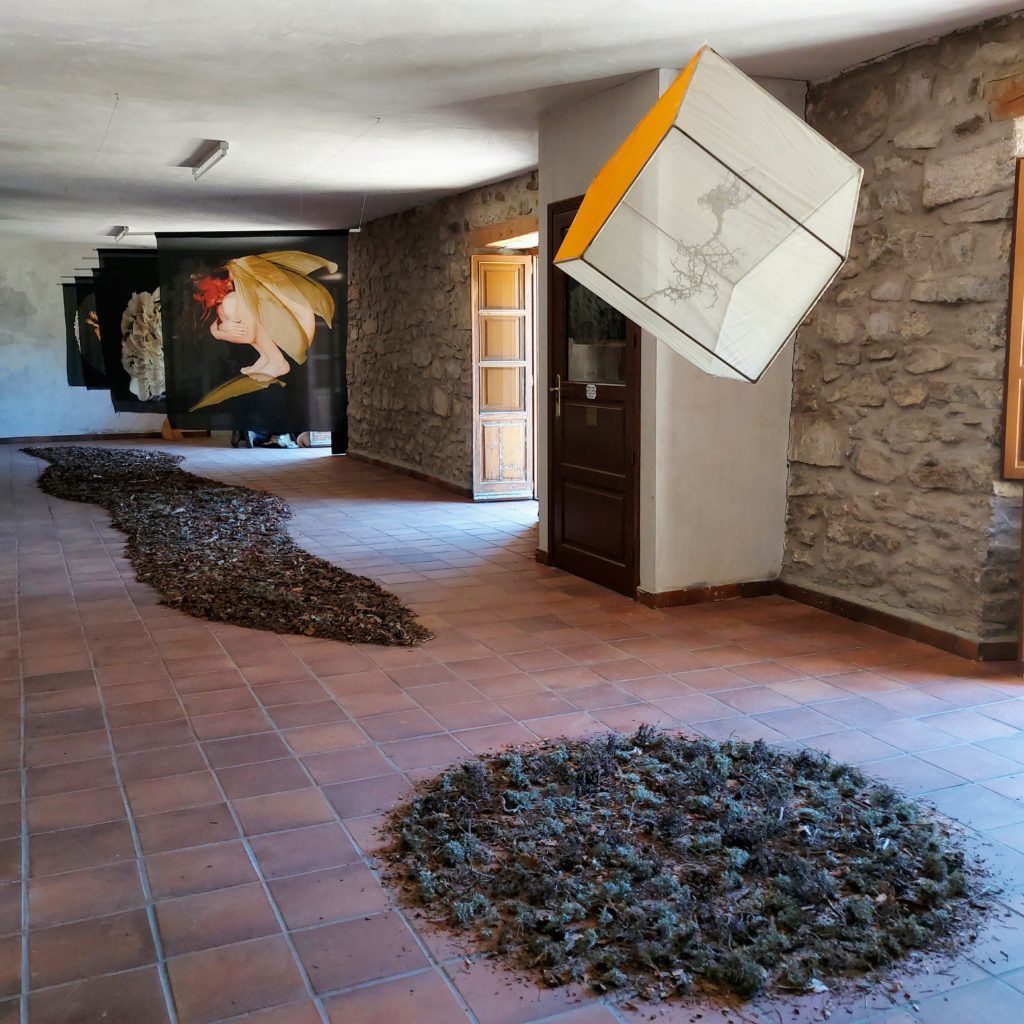
Dialogue With the Clouds, Exhibition view: Sally Kidall’s sculpture in the foreground, collective work in the background. Photo credit: Imke Rust
The theme of Respons-Ability, as giving and taking, is explored as a sacred and creative act. The word is intended as an intentional misspelling of responsibility, confronting an authoritarian perspective of duty and obligation with the ability to respond. ‘Responsibility in and for the worldings in play in these stories requires the cultivation of viral response-abilities, carrying meanings and materials across kinds to infect processes and practices that might yet ignite epidemics of multispecies recuperation and maybe even flourishing on terra in ordinary times and places.’ 1
Dialogue With the Clouds, though consisting of works by individual ZAC members, can be read as a collaborative expression of this line of thought by Donna Haraway, extensively researched by the collective. It also reflects on the words of Andreas Weber, where humans are “deeply (situated) in a web of dynamic living and unfolding creative relationships”.2
Through the means of art making, artists can explore and build new relations with an enlarged community of humans, non-human animals and things or the guardian, the distinctive character or atmosphere of a place: its genius loci.
Through their imagination and open/active/reactive sensory perception, artists can merge within the situation. Artist’s senses are highly fine-tuned to an enlivened world, more consciously aware and interactive with their surrounding environments and human conditions. By making art objects, they build new pathways for communication.
I. ZAC-A COLLECTIVE BECOMING
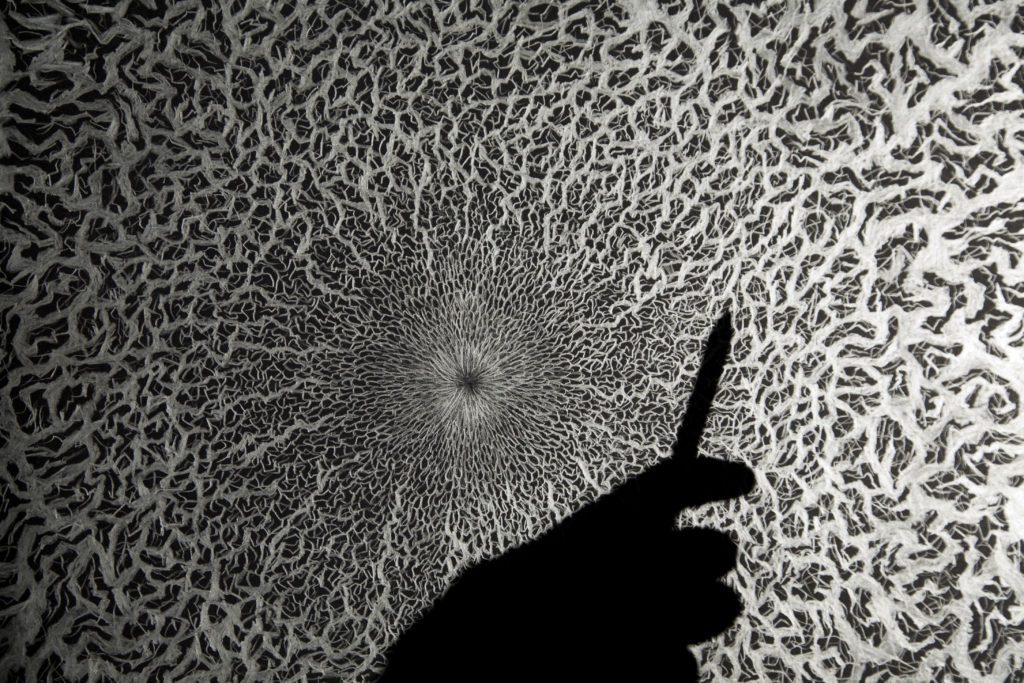
Drawing by Lucia Loren. Photo credit: Lucia Loren
IF THE WORLD can be seen as a knot consisting of billions of lines, it certainly felt like the knot was unravelling when the COVID pandemic became a worldwide reality. Life came to a standstill. Artists lost their commissions, projects, incomes and connections for an unknown stretch of time. But, thanks to the immaterial line of ethereal communication, six female artists started to engage and search for creative strategies. They formed a plural entity displaced across 4 continents connecting Europe, South America, Africa and Australia; different minds thinking together to create a communal body of work. Elena Redaelli (Italy); Karin van der Molen (Netherlands); Lucia Loren (Spain), Karen Macher (Perù), Imke Rust (Namibia/Germany) and Sally Kidall (Australia). They met through their professional, site-responsive, nomadic nature-based art practice developed through international art residency programs, symposiums and art festivals. Since the beginning, a nature-based approach, environmental awareness, openness and sensitivity have been a shared ground of interest.

ZAC members on a Zoom meeting, 2020.
Photo credit: ZAC
The artists connected virtually through weekly meetings and intensive exchanges, creating a virtual platform to brainstorm and research concepts concerning their new confined existence. Moreover, the collective offered vital support in times of extreme emotional discomfort. To escape the harsh new reality, the group explored and developed together ways of practising creative immersion. Alongside rituals of connections with land, they read books together, fed their minds with intellectual stimuli and challenged each other to translate them through the expressive medium of art-making. While working together, tears, fears, waves of laughter, sharing, deep listening and love ran suspended between continents keeping the six ZAC members close. During meetings, ideas were shared, books were presented, films, artworks, and world news were discussed. The first year of ZAC is encapsulated in “Wireless”, a documentary movie by Karin van der Molen accessible online at this link: https://youtu.be/C93kJhbg9O8
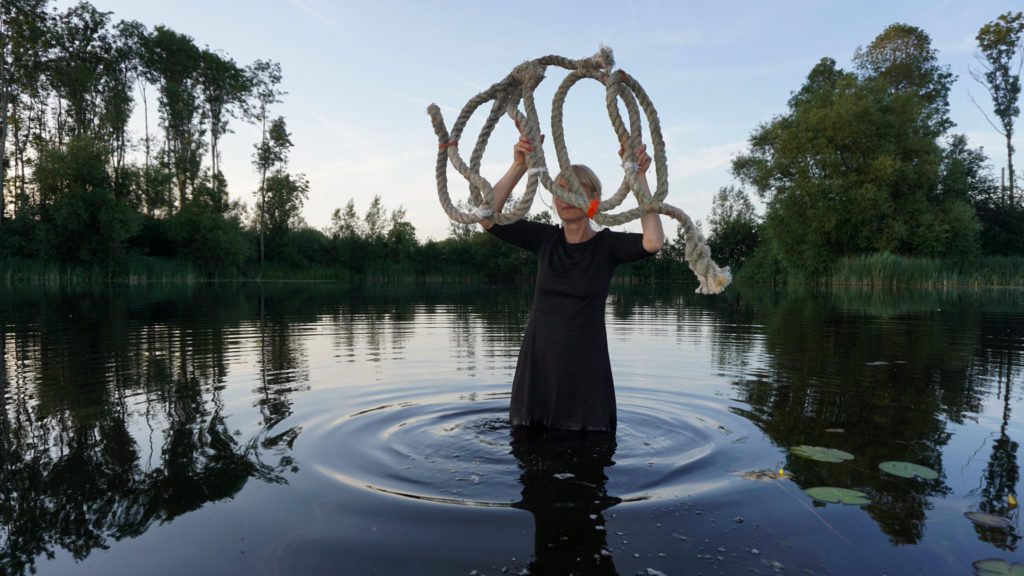
Wireless, Karin van der Molen
Photo credit: Karin van der Molen
These meetings have continued since and resulted in several collaborative projects the collective’s members co-authored.
II. IMMERSION AS AN AFFECTIVE JOURNEY

Immersion with Rocks, Elena Redaelli
Photo credit: Aurelia Matasari
ZAC STARTED EXPLORING the possibilities of living in an unconditional and reciprocal engagement with the world, acknowledging that humans live in a relationship with all beings. They seek creative strategies to connect with dynamic worldviews and bring about an active and positive attitude to face an uncertain future. The group applies intense collaboration and explores co-authored practices based on knowledge sharing to comprehend the symbiotic relationships with our planet’s ecological balance. They explore new approaches to making and thinking through a methodology based on cross-disciplinary experimentation. It can be challenging for individuals to assert and understand one’s boundaries in a collective. Essential in negotiation and decision-making is acknowledging one’s needs while remaining in tune with what’s best for the group, focusing on good listening, cooperation, compromise and empathy. Discussions are often based on art aesthetics to inspire new strands of thought and are grounded in theory. Informed by the ecological anthropology of Tim Ingold, ZAC’s members desire to understand how to “become with” themselves and the subjects of their interest and, according to Ingold, ‘to be alive is to become’. 3
III. A NATURE DANCE
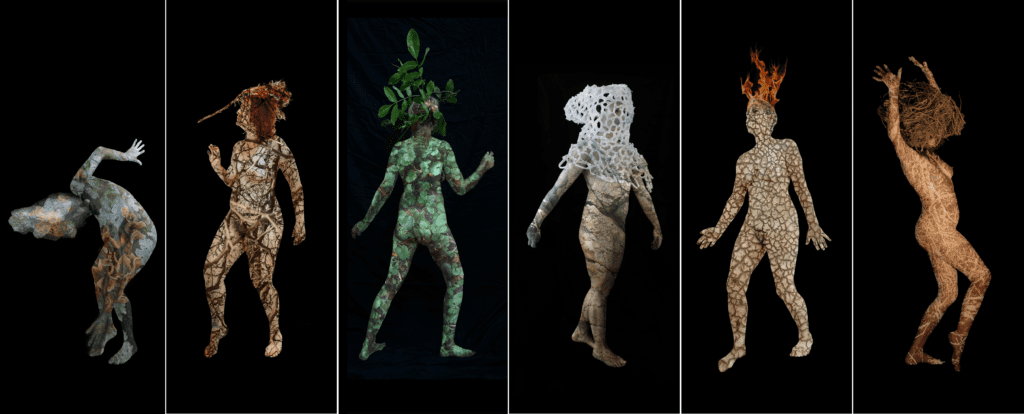
Nature’s Dance, Prints on silk, collaborative project.
Photo credit: ZAC
DURING THE FORCED PAUSE of the pandemic, the collective experienced the healing power of solidarity, becoming even more aware of the relevance of an extended, more-than-human sensibility. They felt the need to develop a cross-species ability for understanding and compassion. For this to happen, the first encounter with the other was a ritual of transformation. Their first major collaborative, site-specific work: ‘Nature’s Dance‘, created for Land Art Andorra 2021, loosely referred to the tribal and ritualistic aspects of Matisse’s ‘Dance’. Through immersion and synchronisation, each artist reconnected with the rhythms and vibrations of their surroundings, acknowledging the inseparable relationship with this living system; that continuously regenerates itself. By experiencing nature’s vibrations with their bodies, the artists understand the intrinsic healing power of natural forces, recognising the need for a greater consciousness about humanity’s role in the web of life.
Taking the visitor on a journey, accompanied by a soundscape, an installation of semi-transparent silk prints presented ZAC in a ritual dance. Elena Redaelli breathed mosses and lichens, letting them grow on the skin; Karin van der Molen hid in a bush until she was utterly camouflaged; Sally Kidall’s body surface cracked like the Australian soil following the bushfires; Imke Rust silently healed her wounds with bramble thorns; Karen Macher, became submerged with seaweed and sea salt, dried in the sun; and Lucia Loren let all the energy of the ground flow through her in celebration.
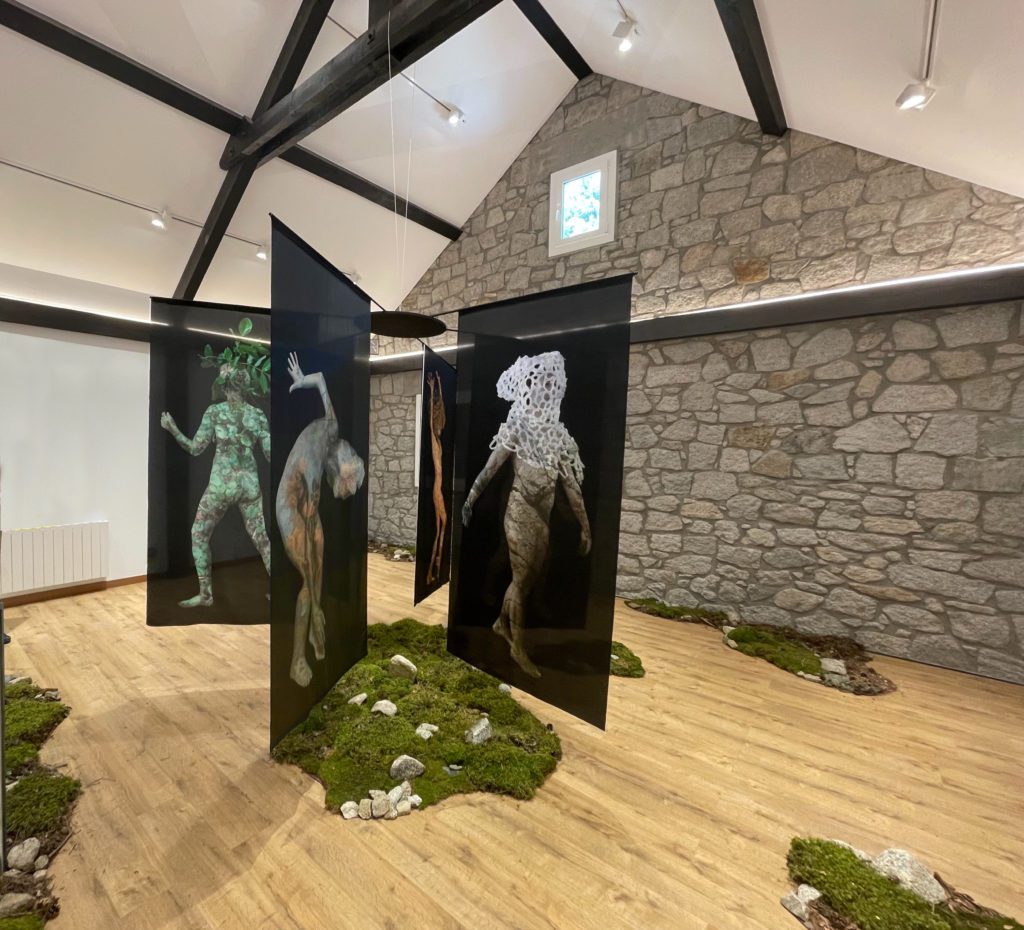
Nature’s Dance, Installation view at Andorra Land Art Biennale
Photo credit: Karin van der Molen
IV. IMAGO INSECTA
DISCOVERING THE WORLD of insects was the start of a new chapter after ‘Nature’s Dance’ had been exhibited successfully. Terra’s beauty, in its multiple forms, has always been a source of fascination and inspiration to each artist’s practice and has already been explored in ZAC’s former projects. Because of their inseparable symbiotic relationships with the ecological balance of our planet, the insect realm seemed the perfect subject for a new investigation initiated in 2021. Each member started to approach and brainstorm their chosen insects through mind-mapping, which soon became the base for the development of Imago Insecta.
Behind ZAC’s project is the idea of learning-with (with one another and the environment) in an active and ongoing exploration of the possibilities that this communal way of being can open up. As Haraway stresses, ‘Becoming is always becoming with, in a contact zone where the outcome, where who is in the world, is at stake”. 4 The forward movement of animals, humans, and others’ evolving lives depends on whom they are with. As a result, a shared process of responses has been activated, a co-responsive movement leading to creative evolution in a dynamic flow of ideas and continuing expressions. If biology proposes that social interaction is only possible amongst members of the same species, the collective argues that a more inclusive society is needed. Based on a relational approach, they refute the hierarchy imposed by the multispecies logic, ready to listen, speak, learn and become another. To overcome the biological capabilities of the human animal, ZAC artists have immersed themselves into the parallel reality of the insect world by engaging in empathic and ecocentric dialogues with particular insects indigenous to their country. An embodied approach was used to capture the insects’ movements; construction processes and material were studied and imitated; attempts were made to reproduce their sounds.
Using various mind-mapping techniques, they have generated speculative narratives and hypothetical imagery using mediums including photographic montage, conceptual installations, textiles, drawing, sculpture and embroidery. They moved from scientific and biological study to observation and documentation through video, photography and drawing to embrace the subjects fully from different perspectives.

Elena Redaelli and Sally Kidall mind-mapping in Dakar.
Photo credit: Karin van der Molen
‘Imago Insecta’ was first displayed in Africa as a part of the Dak’Art OFF 2022, Biennale in Dakar, Senegal. Here the collective explored and assembled their research and tested their ideas in a physical context. On a large white wall, they directly re-created by hand, drawing all artist’s mind maps displaying their research and mutual thinking processes. Opposite this, six silk-printed images presenting the first stage of psychological/physical metamorphosis were suspended, animated by the wind. As well, out of an intimate personal dialogue with their insect, each artist created individual works.
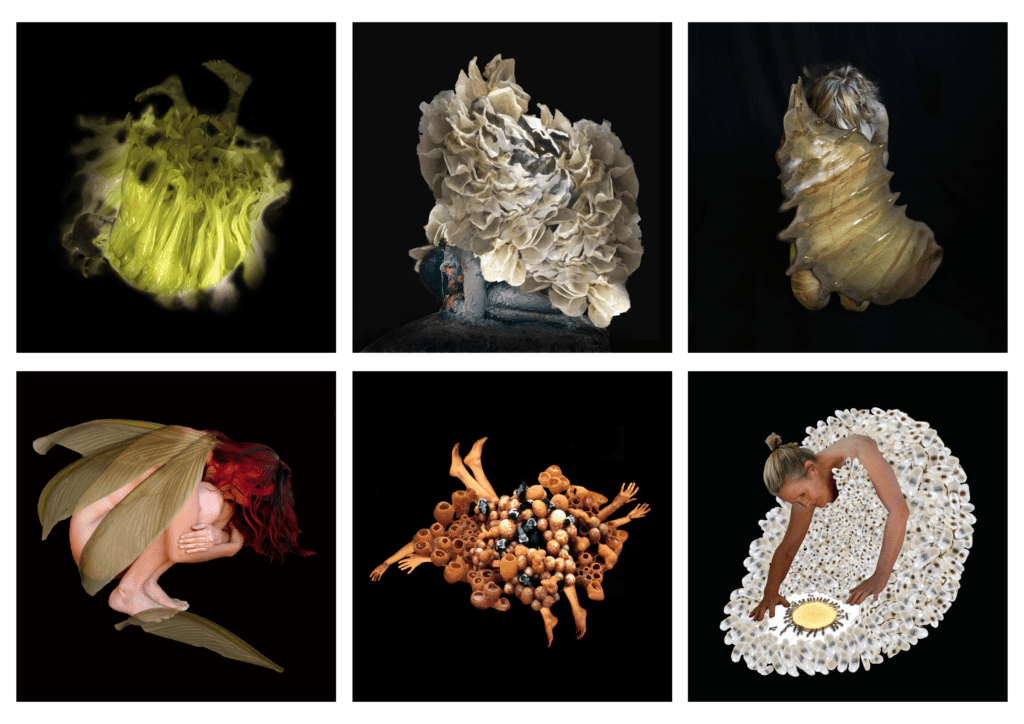
Imago Insecta collective work, prints on silk.
Photo credit: ZAC
Imke Rust entered a creative dialogue with the African termite, exploring the intersection of science and myth. From this engagement, new intuitive and speculative narratives emerged, expressed in various media such as drawing, collages, installations and videos.
In my work, I try to go into a deep correspondence with the termite – a being I am familiar with since I grew up on a farm in Namibia scattered with termite heaps.
Does the Termite queen really live forever? Is the termite hill a body, a self-regulating organic process that continuously reacts to its changing environment? Are the elements of a termite colony relevant to understanding colonisation? These and many more questions from my research guide me in my open creative, dialogical process and correspondence with the termites.
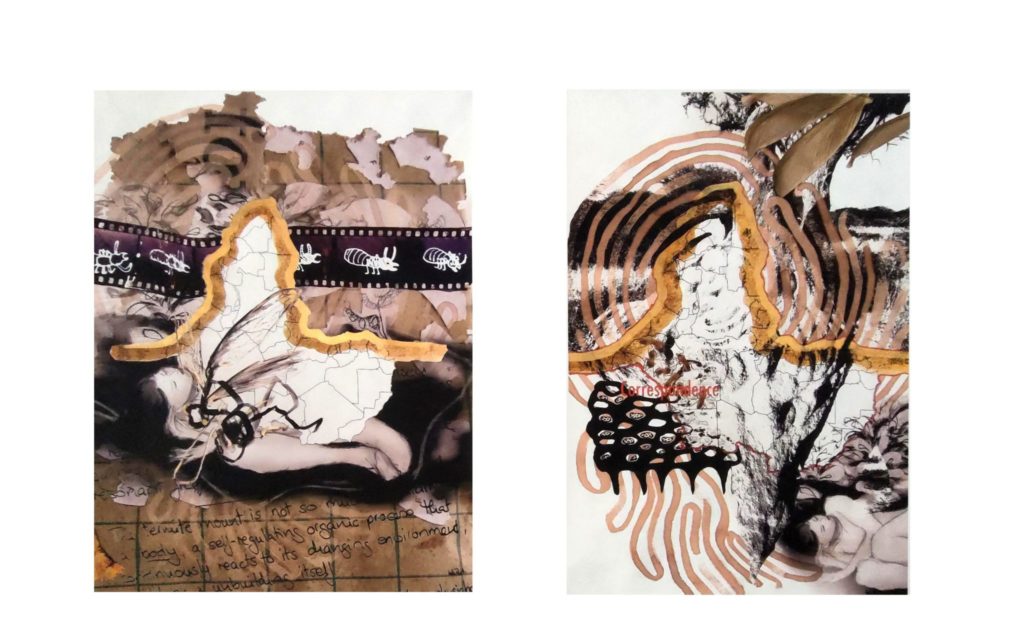
Self-Regulating Body and Correspondence, mixed media collages printed on Tyvek, 1680×1188cm each
Photo credit Imke Rust
Imke collaborated with Elena Redaelli in creating large collages exploring the interdependence between insects, nature and humans. The collage technique allows them to imagine new narratives combining images from various contexts in a world free of human rules. So, as if storytelling in the insect’s world were the same as in the human’s, Redaelli imagines the fig and wasp relation as one of passion, tragedy, dedication, sacrifice and boundless love among different species in a mutualistic symbiosis. These insect and tree species’ very existence and evolution happen in a system of co-dependency. The Female wasp is so attracted to ripe figs as to penetrate its inflorescence through a small hole to lay her eggs inside. In doing so, she loses her wings, and her antennae are broken off, so she can no longer get out. She lays her eggs inside and dies. This relationship, essential for the survival of two different species, was not straightforward and did not predictably occur but was generated by the successful interaction between two apparently separate parts of the environment.
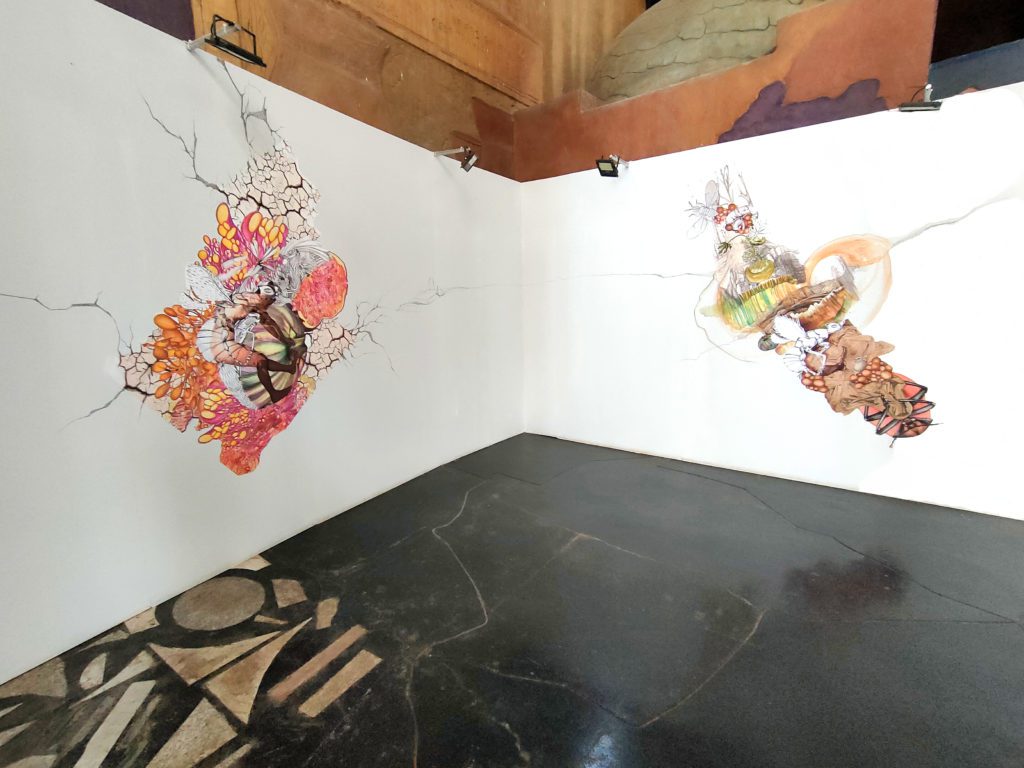
The Fig and the Wasp, Elena Redaelli
Photo credit Elena Redaelli
Incredible and mutualistic relations were also the basis of Lucia Loren’s work. She explored the critical role of dung beetles in transforming animal waste into soil nutrients. She developed a recipe combining clay and dung, creating a series of tiny pots and experimenting with various installations. In her drawings, through careful reproduction of lines, dots, and different organic patterns, she traces the brewing vitality of the invisible microscopics that live hidden in the soil.
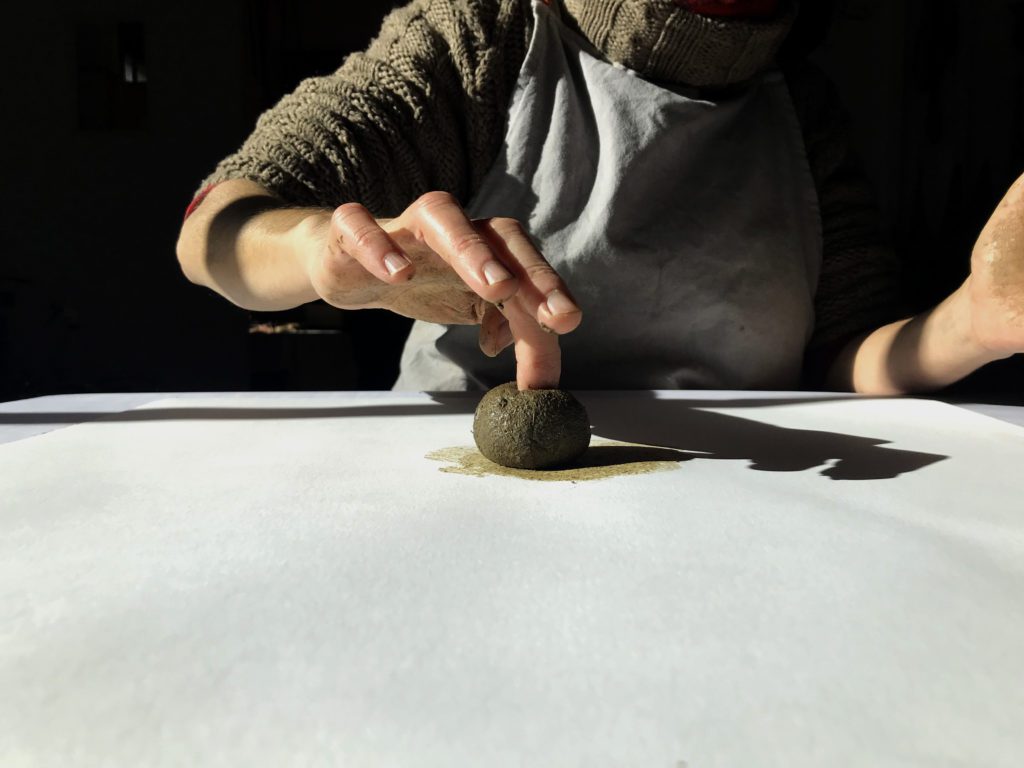
Exploring dung beetles, Lucia Loren
Photo credit: Lucia Loren
Lucia’s underground tunnels are the same where Sally’s ants wander; well hidden from human eyes, the laborious insects collectively work for their species’ survival. Sally has immersed herself into the world of Australian ants, discovering how vital their role is in balancing ecosystems through soil regeneration, nutrient recyclers and release, pollinators and pest control. However, on the planet’s surface, in contact with humans, they become a source of irritation. She examined various human defensive systems designed to protect and insulate us from our fears of and vulnerability to insect contact.
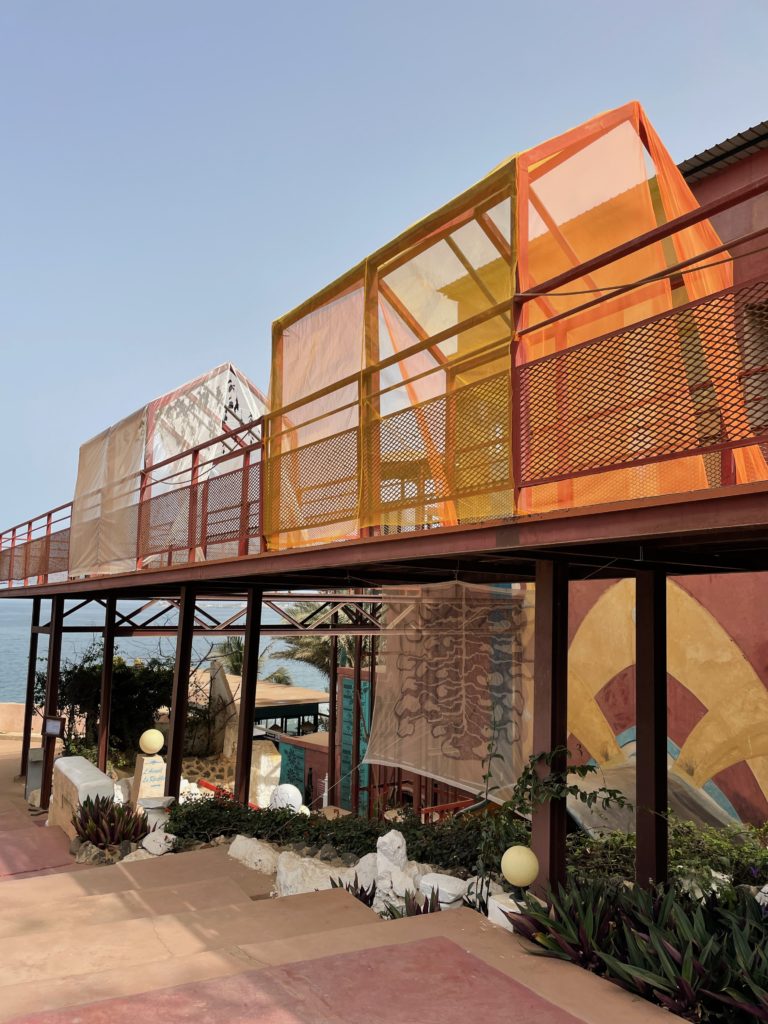
Containment, Sally Kidall site-specific installation.
Photo credit: Sally Kidall
Sally created an experiential site-specific installation consisting of a series of fabric enclosures that visitors walk through as they enter the exhibition using scent, colour, sound and physical barriers and asking: are all insects pests?
Again, the crucial role of insects in the regeneration of our planet is inquired in Karin van der Molen’s work – A Fly’s Vision, where she embroidered a collage imagining how a fly perceives nature through its multifaceted eyes that see the world in a myriad of blurred colours.
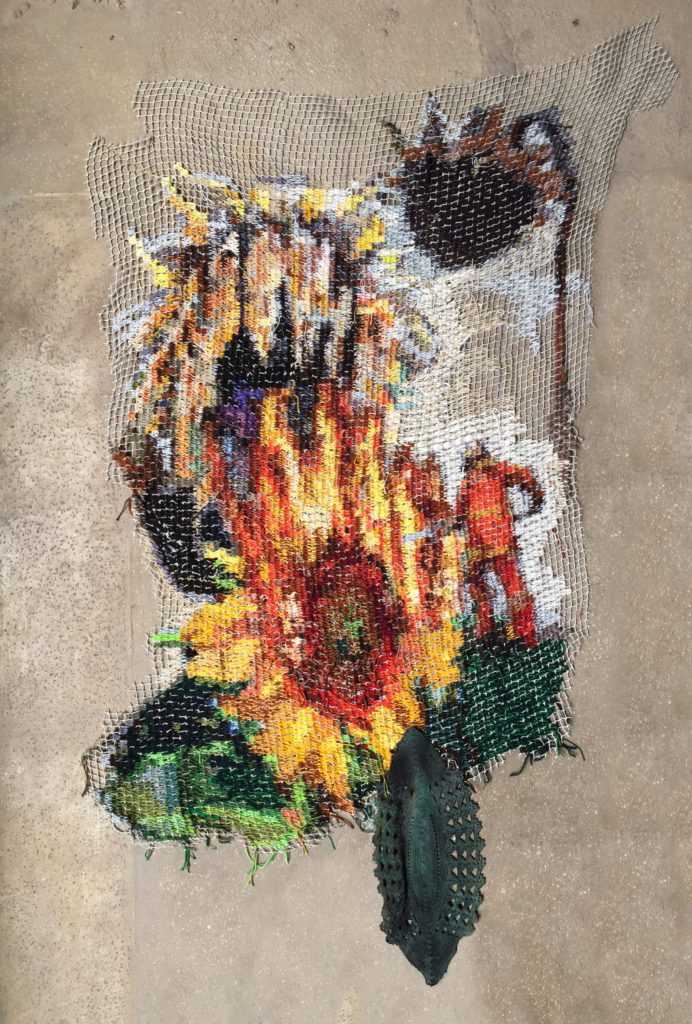
A Fly’s Vision, embroidered collage, Karin van der Molen
Photo credit: Karin van der Molen
The work comments on both the way insects indulge in their colourful environment without judgement and the perilous situation that threatens their survival due to the destructive activities of humans. The fly caught Karin’s attention because of its crucial role in the life cycle on earth. They are the great digesters of dead material and cattle dung transforming it into soil nourishment for new growth. Her research gave her an inspiring thought: ‘death is not a final end, but a movement along the lines in the infinite meshwork, without which life would not be possible’. Death as a beginning of a new life cycle is taken forward in Karen Macher’s sculpture conceived during the first year of the COVID pandemic when the world became paralysed, and there seemed no way out. She wrote:
I wove a cocoon with woods, my own cocoon, for not thinking of anything else. It was a long process. I felt vulnerable while weaving; my transformation was imminent. And the whole process came with the certainty of knowing that, if I could overcome all that process, I could be on my way to evolving into a better version of myself.
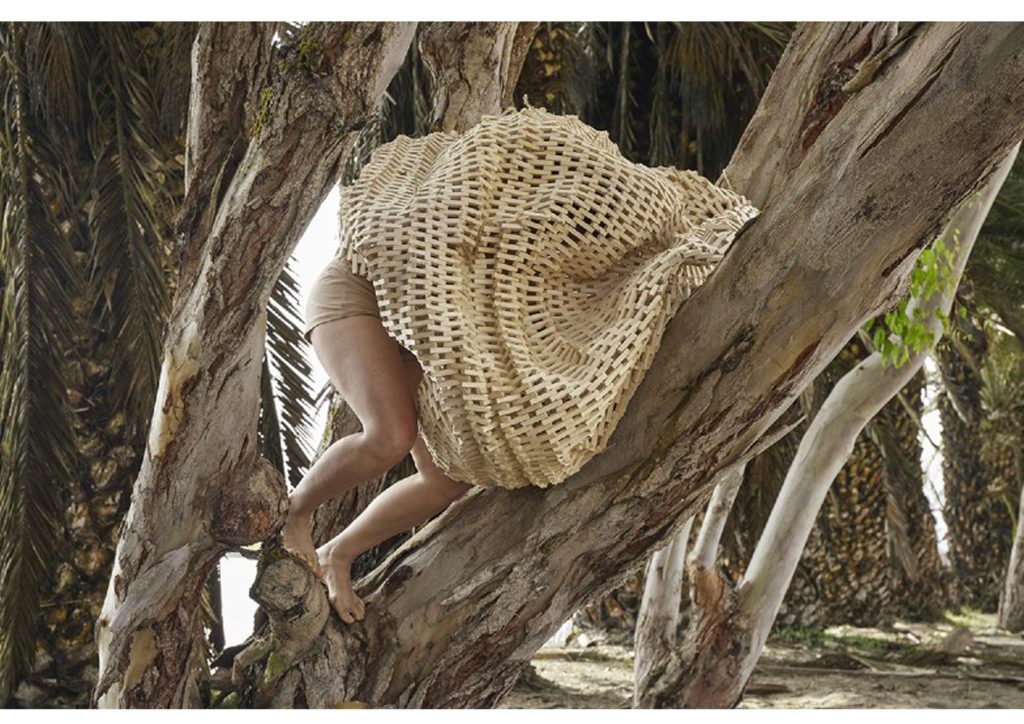
Metamorphosis, video, performance, sculpture by Karen Macher.
Photo credit: Juan Pablo Murrugarra
ZAC’s ‘Imago Insecta’ is an evolving project, an ongoing extended narrative. Sally Kidall and Imke Rust will build “Residenza Insecta” for the Parco d’Arte – RespirArt in Pampeago, Italy. ‘Residenza Insecta’ offers a residency for various insects, stressing the importance of positive collaboration between humans and other living beings within our ecosystems. The work is a speculative interpretation of insect habitation, imitating how insects build their nests and live in organised colonies; it suggests the combination of various elements in a cluster as if they could house different species and live as a single body. In 2023 Imago Insecta will be part of the Cafka Biennale, reaching another metamorphosis or stage of life.
V. WAYS FORWARD
ZAC HAS NOW a two-year-long relationship, starting as a natural need to stay in contact with like-minded artists during the pandemic. Initially, there was no plan, no agenda, just the certainty and pleasure of meeting every Monday for about two hours. It was a space of comfort that soon developed into a multi-layered and deep connection. The first terrain of experimentation was and still is the willingness to create a complex and nurturing process where the singular is constantly confronted by the plurality of a community, continuously pushing the boundaries of one’s beliefs and visions while the differences are recognised and understood in a practice of care. Collaborative projects help to focus and determine themes that fit the group. Within the process, there is space for uncertainty, doubts and worries challenged by the geographical distance of members living over four continents. However, even if each artist’s life, dividing time between studio, jobs, commissions, family and ZAC impact the shared process, ZAC intends to further develop their investigations by implementing new ways of researching and approaching reality. Actively exploring the possibilities of human life and that of the planet, staying in tune with the world’s dynamism and recognising the importance of being active and sensitive to becoming together. Knowledge sharing and empathy are creative tools to trigger ideas and processes that can potentially destabilise preconceived personal and social structures leading to new, more careful and sustainable ways of thinking and living. ZAC plans to extend into the physical realm of intense, uninterrupted creation, weaving together and deepening their individual and collective process-orientated research.
ENDNOTES
- Staying with the Trouble, Donna Haraway, 2016
- Enlivenment, Andreas Weber, 2019
- Anthropology Beyond Humanity, Tim Ingold, 2013
- When Species Meet, Donna Haraway 2008
WEAD MAGAZINE ISSUE No. 13, THE ART OF EMPATHY
Published November 2022
